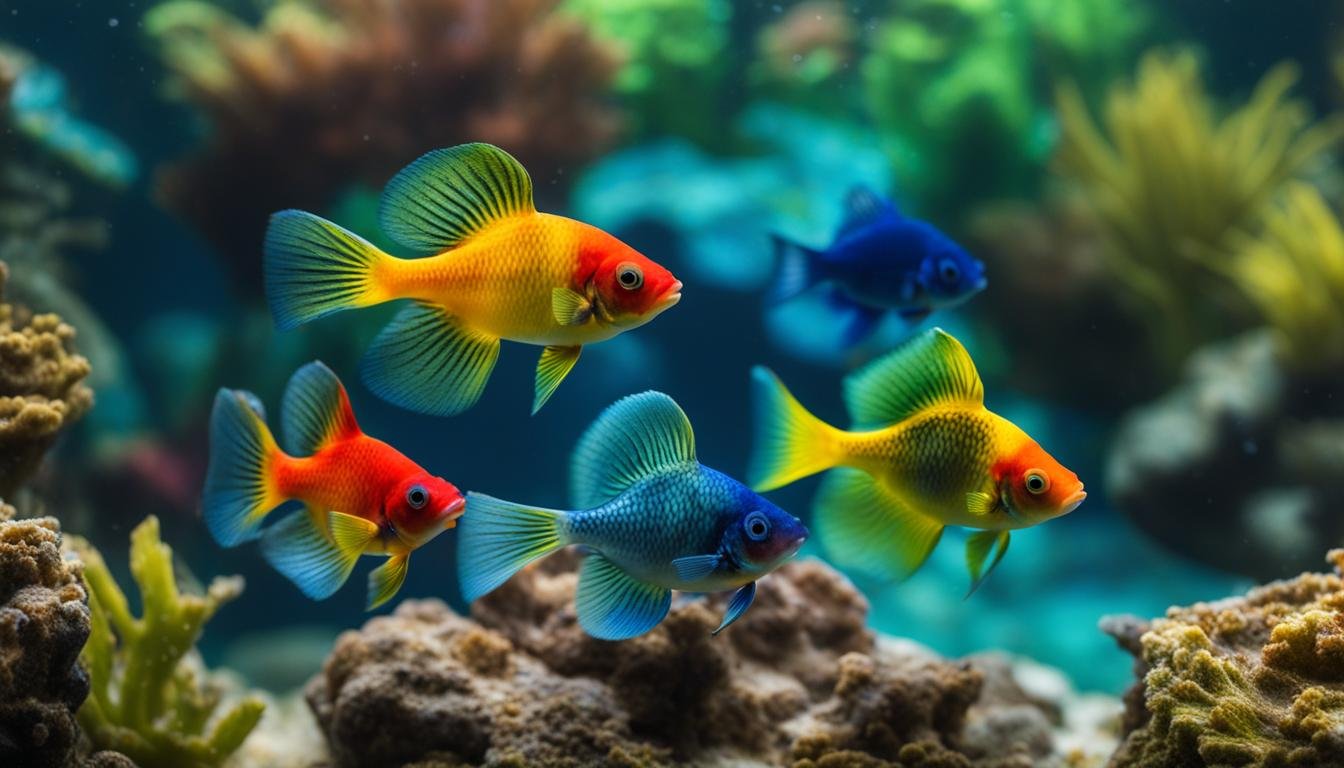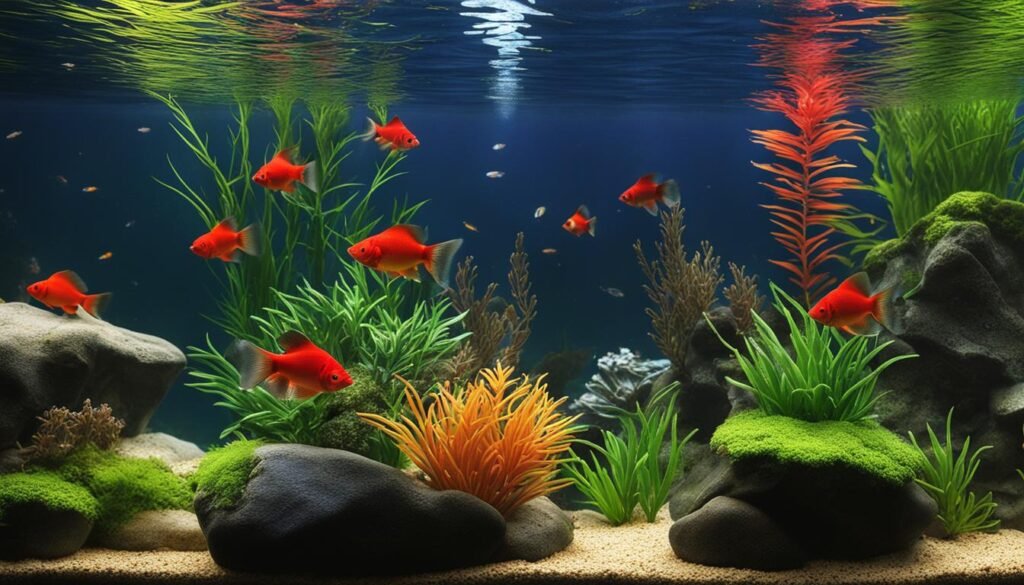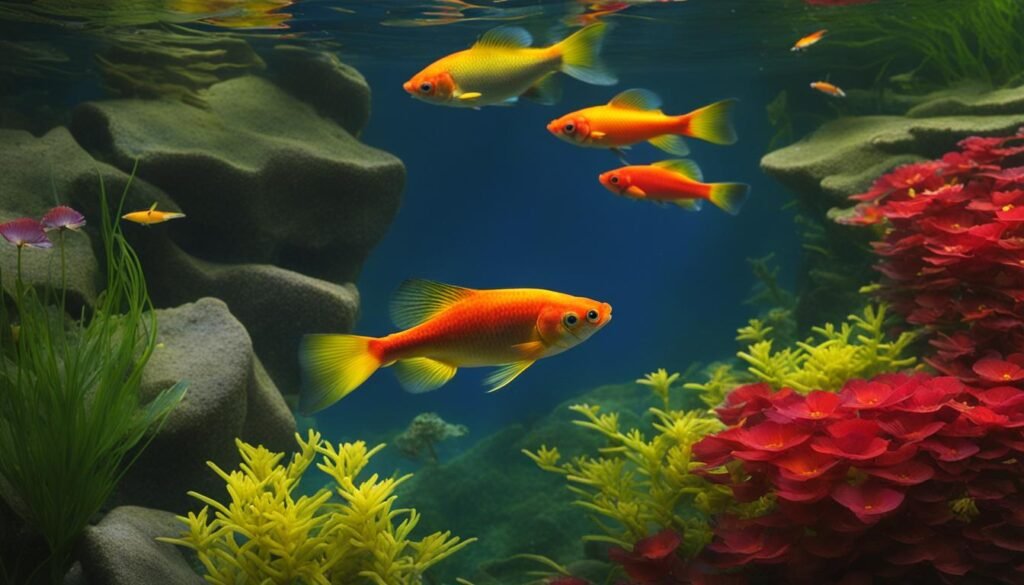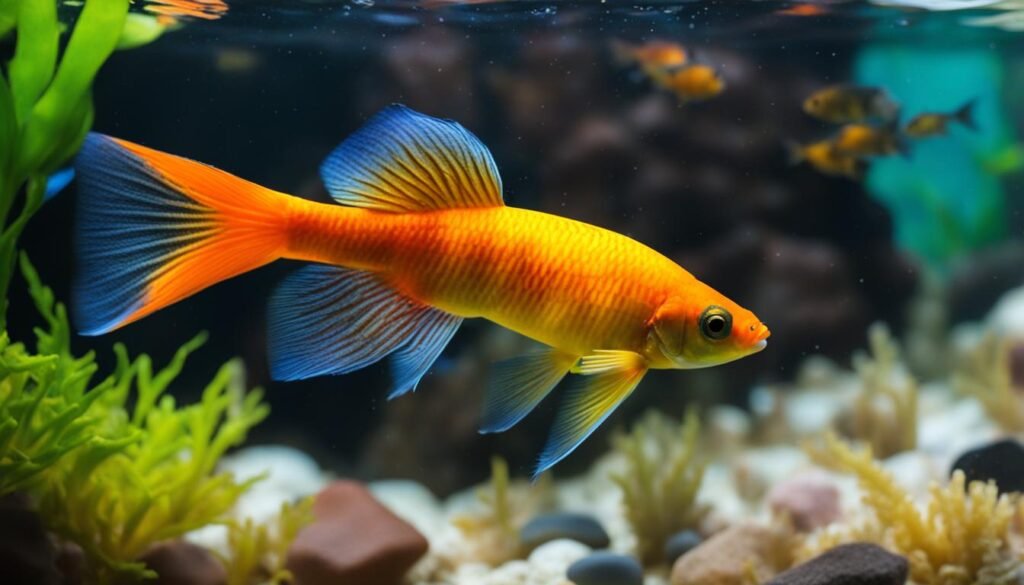Your cart is currently empty!

Are Platy Fish Livebearers? Learn Fascinating Facts!
Welcome to our guide on Platy Fish, where we explore the intriguing world of these popular livebearers in the freshwater aquarium hobby. If you’re curious about whether Platy Fish are livebearers, interested in their breeding habits, or seeking tips on their care, you’ve come to the right place! Let’s dive in and discover some fascinating facts about Platy Fish.
Key Takeaways:
- Platy Fish are livebearers and give birth to live young.
- They are native to Mexico and Central America.
- Platies can crossbreed with each other and swordtail species, resulting in a variety of color variations.
- They are easy to breed and suitable for both beginners and experienced hobbyists.
- Proper care includes providing a suitable tank, balanced diet, and monitoring population control.
What are the different types of Platy Fish?
Platies are known for their stunning array of colors and patterns, making them a popular choice among aquarium enthusiasts. Here are some of the different types of Platy Fish:
Mickey Mouse Platy
The Mickey Mouse Platy is named for the distinct marking near its tail, which resembles the iconic shape of Mickey Mouse. Its vibrant colors and playful pattern make it a favorite among fish keepers.
Sunburst Platy
The Sunburst Platy boasts beautiful yellow and orange colors that resemble a burst of sunlight. Its vibrant hues can add a cheerful and tropical touch to any aquarium.
Red Wag Platy
The Red Wag Platy is characterized by its striking red tail with a white edge. This contrast creates a visually appealing fish that can easily catch the eye.
Blue Platy
As the name suggests, the Blue Platy exhibits a stunning blue coloration. Its iridescent scales shimmer under the aquarium lights, creating a captivating sight.
These are just a few examples of the many color and pattern variations available in the world of Platy Fish. Whether you prefer vibrant hues or unique markings, there is a Platy Fish type to suit every aquarium enthusiast’s taste.
Next, let’s explore how to set up a suitable tank for these beautiful fish.
How to Set Up a Platy Fish Tank

If you’re considering adding Platy Fish to your aquarium, it’s important to set up their tank properly to ensure their health and well-being. Follow these steps to create an ideal environment for your Platy Fish:
1. Tank Size and Requirements
Platy Fish can thrive in a 10-20 gallon aquarium or larger. Provide them with enough space to swim and explore. Maintain a pH range of 6.8-8.5 and ensure the water is moderately hard. Regularly clean the tank and perform water changes to maintain water quality.
2. Adding Live Plants
Consider adding live aquarium plants to your Platy Fish tank. These plants help consume organic waste, provide hiding places for the fish, and add oxygen to the water. Some suitable options include Java Fern, Anubias, and Hornwort.
3. Choosing Tank Mates
When selecting tank mates for your Platy Fish, choose peaceful community fish that are similar in size. Good companions include tetras, rasboras, cory catfish, snails, bristlenose plecos, and rainbowfish. Platy Fish can also coexist with betta fish as long as there is enough territory for each fish.
By following these guidelines, you can create a suitable and thriving habitat for your Platy Fish. Remember to monitor water conditions regularly and provide proper care to ensure the longevity and happiness of your fish.
What do Platy Fish eat?
Feeding your Platy Fish a balanced diet is crucial for their overall health and well-being. These omnivorous fish have a diverse palate and can consume a variety of foods. When it comes to their diet, it’s important to provide a mix of high-quality flakes, pellets, freeze-dried foods, and frozen foods.
Platy Fish thrive when given a diverse range of proteins, vegetables, algae, vitamins, and minerals. This ensures they receive all the necessary nutrients for proper growth and development. You can feed them commercial fish food specifically formulated for livebearers, as well as supplement their diet with live or frozen brine shrimp, bloodworms, and daphnia.
What to feed adult and growing Platy Fish:
- High-quality flakes and pellets
- Freeze-dried foods such as brine shrimp and bloodworms
- Frozen foods like daphnia
- Vegetables like blanched spinach and lettuce
- Spirulina or algae-based foods
It’s important to feed adult platies once a day, providing them with only the amount they can consume within a few minutes. For growing juveniles, two to three small meals a day may be necessary to support their rapid development.
Supplementing Platy Fish diet:
- Live or frozen brine shrimp
- Live or frozen bloodworms
- Live or frozen daphnia
Adding variety to their diet with live or frozen foods like brine shrimp, bloodworms, and daphnia not only provides them with additional nutrients but also mimics their natural foraging behavior.
Key Points:
- Platy Fish are omnivorous and require a balanced diet.
- Provide a mix of high-quality flakes, pellets, freeze-dried, and frozen foods.
- Supplement their diet with live or frozen brine shrimp, bloodworms, and daphnia.
- Feed adult platies once a day, juveniles may require two to three small meals.
- Adding variety with live or frozen foods supports their natural foraging behavior.
How often do Platy Fish breed?

Platies are prolific breeders and can reproduce frequently under optimal conditions. Female platies have the ability to give birth to a large number of fry every month, with an average of 20 to 50 babies per brood. This reproductive capability, combined with their quick maturity rate, means that platies can start breeding as early as four months of age.
Unlike some other species, platies do not provide parental care to their offspring. In fact, adult platies may even eat the fry if given the opportunity. To increase the survival rate of the fry, it is recommended to provide hiding places in the tank, such as decorations, rocks, wood, or live plants. These hiding spots allow the fry to seek shelter and protection from adult platies, increasing their chances of survival.
To manage the breeding and prevent overcrowding in the tank, it is important to have a plan in place for the fry. Excess fry can be given away to friends, donated to pet stores, or even sold to local fish enthusiasts. Providing hiding places and dense vegetation can also help control the population, as some fry may seek refuge and thrive in a well-planted community tank.
Key Points:
- Female platies can give birth to 20 to 50 babies per month.
- Platies can start breeding as early as four months of age.
- Adult platies do not provide parental care and may even eat the fry.
- Provide hiding places in the tank to increase the survival rate of the fry.
- Have a plan in place for managing excess fry, such as giving them away or donating/selling them.
Platy Fish Tank Requirements: Creating the Perfect Habitat

Creating a suitable habitat for your Platy Fish is crucial to their overall health and well-being. By understanding their tank requirements, you can ensure that your Platy Fish thrive in their environment. Here are some important factors to consider:
Aquarium Size and Setup
Platy Fish can be housed in a 10-20 gallon aquarium or larger, providing them with ample space to swim and explore. It is important to set up the tank with a proper filtration system to maintain water quality. Regular water changes are also necessary to keep the tank environment clean. Adding live plants not only enhances the aesthetic appeal but also serves as hiding spots and helps maintain water quality by absorbing excess nutrients.
Water Conditions
Platy Fish prefer a pH range of 7-8.5 and moderate to hard water. It is important to monitor the pH levels regularly to ensure it remains within the appropriate range. Testing kits are available at pet stores to help you measure the water parameters accurately. Maintaining proper water temperature, ideally between 70-78°F (21-25°C), is essential for the well-being of your Platy Fish.
Tank Mates
When selecting tank mates for your Platy Fish, it is important to consider their compatibility. They can coexist peacefully with similar-sized community fish such as tetras, rasboras, cory catfish, snails, bristlenose plecos, and rainbowfish. It is recommended to avoid aggressive or fin-nipping species that may cause stress or harm to your Platy Fish.
In summary, providing a proper tank setup, maintaining optimal water conditions, and selecting compatible tank mates will create an ideal habitat for your Platy Fish. By meeting their tank requirements, you can ensure the health and happiness of your aquatic companions.
How Long Do Platy Fish Live?
Platy fish, also known as platies, have an average lifespan of 3-4 years when provided with proper care and a suitable environment. With good nutrition, clean water, and low stress levels, some individuals may even live up to 5 years or more. It’s important to note that individual lifespan can vary depending on genetics and specific environmental factors.
Creating a healthy and balanced habitat for your platies is key to ensuring a long and happy life. Maintaining clean water conditions by regularly monitoring and conducting water changes is essential. A pH range of 7-8.5 and moderate to hard water is preferred by platies. Providing a varied diet that includes high-quality flakes, pellets, and live or frozen foods will help meet their nutritional needs.
As with any fish, stress can have a negative impact on their lifespan. To reduce stress, it’s recommended to keep platies in groups of three to six, with a ratio of at least two females for every male. Ensuring ample space and hiding spots, such as decorations or live plants, can also help decrease stress levels. By providing a suitable environment and proper care, you can maximize the lifespan of your beloved platy fish.
Can Platy Fish Live in a Pond?

Platy fish, specifically the Variatus platy species, can thrive in outdoor mini ponds during the warmer summer season. This makes them a great addition to your outdoor living space or garden. However, it is important to ensure that the water conditions are suitable for their well-being. Variatus platies are hardy fish that can adapt to a variety of water conditions, but they do prefer a pH range of 7-8.5 and moderate to hard water.
When setting up a mini pond for platy fish, it is crucial to provide adequate space and hiding spots for them. This can be achieved by incorporating decorations, rocks, wood, or live plants into the pond. These features not only create a more natural and visually appealing environment but also offer shelter and hiding places for the fish, reducing stress and promoting their overall well-being.
Benefits of Keeping Platy Fish in a Pond:
- Close-to-nature experience: Observing platy fish in an outdoor pond provides a closer-to-nature experience, allowing you to appreciate their beauty and behavior in a more natural setting.
- Increased space: Unlike aquariums, ponds offer more space for platy fish to swim and explore, promoting their physical health and mental stimulation.
- Self-sustaining ecosystem: Ponds can establish a self-sustaining ecosystem, with beneficial microorganisms and aquatic plants contributing to natural filtration and oxygenation of the water.
- Enhanced aesthetics: Platy fish in a pond can enhance the overall aesthetics of your outdoor space, adding vibrant colors and movement to your garden or patio.
With proper planning and consideration of the platies’ needs, setting up a mini pond can provide a wonderful environment for these beautiful fish, allowing them to thrive and bring joy to your outdoor space.
How many Platy Fish should be kept together?

When it comes to keeping Platy Fish, it’s important to consider the group size and male to female ratio for a harmonious and balanced aquarium. A group of three to six platies is a good starting point, as it allows for social interaction and reduces stress. However, it’s also crucial to maintain the right male to female ratio to prevent excessive breeding aggression and ensure the well-being of the female platies.
Male platies are known for their constant desire to mate, so it is recommended to have at least two females for every male in the tank. This helps distribute mating opportunities and reduces stress on the females. It also prevents a single female from being continuously pursued by multiple males, which can lead to aggression and potential harm.
To determine the male to female ratio, carefully observe the behavior of the platies in your tank. If you notice any signs of aggression or excessive mating attempts, it may be necessary to adjust the ratio. Adding more females or removing some males can help balance the population and create a more harmonious environment for your platies.
Key Points:
- A group of three to six platies is recommended for a balanced tank.
- Maintain a male to female ratio of at least two females for every male.
- Observe the behavior of your platies and make adjustments to the ratio if necessary.
By considering the group size and male to female ratio, you can ensure a healthy and thriving community of Platy Fish in your aquarium. Remember to monitor the population and make adjustments as needed to maintain a peaceful and enjoyable environment for your aquatic pets.
What should you do with Platy Fish fry?

Platy Fish are known for their prolific breeding habits, and if not controlled, the population can quickly grow out of hand. So, what should you do with all those adorable fry? Here are some options to consider:
- Give them away: If you have friends or fellow aquarium enthusiasts who are interested in adding Platy Fish to their tanks, giving away the fry can be a great option. It not only helps you control the population but also allows others to enjoy these beautiful fish.
- Donate to pet stores: Many local pet stores accept surplus fry and may even offer store credit in return. Contact your nearest pet store to inquire about their fry donation policies and potential compensation.
- Sell to local fish stores: If you’re interested in breeding Platy Fish for profit, you can sell the offspring to local fish stores. This can be a rewarding way to offset some of the costs associated with maintaining your aquarium.
- Increase survival rate: To increase the survival rate of the fry in a community tank, provide plenty of hiding places, such as decorations, rocks, wood, or live plants. Dense vegetation also serves as a natural shelter and food source for the fry, ensuring they have the best chance of survival.
Remember, it’s essential to control the population of Platy Fish to maintain a healthy and balanced aquarium. By exploring these options and taking proactive measures, you can ensure the well-being of both the adult fish and their fry.
Conclusion
In conclusion, Platies are a wonderful addition to any freshwater aquarium. With their vibrant colors and ease of care, they are a popular choice among hobbyists. Whether you’re a beginner or an experienced fish keeper, Platies are a great choice due to their adaptability and hardiness.
Platies come in a variety of colors and patterns, offering a beautiful array of options for your tank. From the iconic Mickey Mouse Platies to the vibrant Sunburst and Blue Platies, there is a color variation to suit every taste.
Proper tank setup, including suitable tank mates and water conditions, is crucial for the health and well-being of your Platies. Providing a balanced diet and maintaining a clean tank will help ensure their longevity. Remember to monitor the population and adjust the male to female ratio to prevent overcrowding and excessive breeding aggression.
In conclusion, Platies are a joy to keep and watch in your aquarium. Their lively nature and ability to breed readily make them a fascinating and rewarding species to care for. So go ahead, set up your tank, and enjoy the beauty and charm that Platies bring to your aquatic world!
FAQ
Are Platy Fish livebearers?
Yes, Platy Fish are livebearers, meaning they give birth to live young instead of laying eggs.
What are the different types of Platy Fish?
There are various types of Platy Fish, including Mickey Mouse Platy, Sunburst Platy, Red Wag Platy, Blue Platy, and many more.
How do you set up a Platy Fish tank?
To set up a Platy Fish tank, you will need to provide suitable tank mates, proper filtration, and maintain water conditions within their preferred pH range.
What do Platy Fish eat?
Platy Fish are omnivores and can be fed a variety of foods, including high-quality flakes, pellets, freeze-dried foods, and frozen foods.
How often do Platy Fish breed?
Platy Fish can breed frequently, with females capable of giving birth to 20 to 50 babies per month under optimal conditions.
What are the housing requirements for Platy Fish?
Platy Fish can be housed in a 10-20 gallon aquarium or larger, with a pH range of 6.8-8.5 and harder water. They can be kept with similar-sized community fish.
How long do Platy Fish live?
With proper care, Platy Fish can live up to 3-4 years, although some individuals may live longer.
Can Platy Fish live in a pond?
Variatus Platy Fish are particularly well-suited for outdoor mini ponds during the warmer summer season, as long as water conditions and hiding spots are provided.
How many Platy Fish should be kept together?
It is recommended to keep a group of three to six platies together, with at least two females for every one male to reduce stress and prevent excessive breeding aggression.
What should you do with Platy Fish fry?
If you have excess fry, you can give them to friends, donate them to pet stores, or set up hiding places and dense vegetation in the tank to increase their survival rate.
Leave a Reply